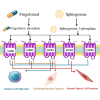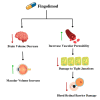Fingolimod-Associated Macular Edema in the Treatment of Multiple Sclerosis
- PMID: 37551255
- PMCID: PMC10404465
- DOI: 10.7759/cureus.41520
Fingolimod-Associated Macular Edema in the Treatment of Multiple Sclerosis
Abstract
Multiple sclerosis is a neurological disorder categorized by inflammatory processes with a high prevalence worldwide. It affects both motor and sensory pathways and is also associated with the visual pathway. Fingolimod is a commonly used drug for relapsing-remitting multiple sclerosis. It is a sphingosine 1-phosphate modulator acting on its receptors for immune cell accumulation, neuronal function, embryological development, vascular permeability, smooth muscle cell function, and endothelial barrier maintenance. This review aims to understand the processes, mechanisms, risks, and management of fingolimod-associated macular edema. Due to the anti-inflammatory properties of fingolimod, it decreases various cytokines, including interleukin (IL)-1B and IL-6, spike wave, and spike amplitude, in electrophysiological activities and decreases insoluble receptors for advanced glycation end product ligand. A daily dosage of 0.5 mg of fingolimod has an increased association with macular edema. The serious adverse events of fingolimod are lymphopenia, cardiovascular events, ocular events, and carcinoma. Fingolimod decreases brain volume and increases vascular permeability, resulting in increased macular volume and damage to the blood-retinal barrier, which causes an increased risk for macular edema. Cystoid macular edema is more common in older individuals suffering from comorbidities affecting the retina, such as diabetes, or those undergoing ophthalmological surgeries. This review also highlights the importance of regular ophthalmology examinations on patients consuming fingolimod both in the initial stages and chronic use. The treatment options for macular edema include nonsteroidal anti-inflammatory drugs, acetazolamide, triamcinolone, ketorolac, corticosteroids, and intravitreal procedures.
Keywords: adverse effects; fame; fingolimod; macular edema; multiple sclerosis.
Copyright © 2023, Khan et al.
Conflict of interest statement
The authors have declared that no competing interests exist.
Figures


References
Publication types
LinkOut - more resources
Full Text Sources
